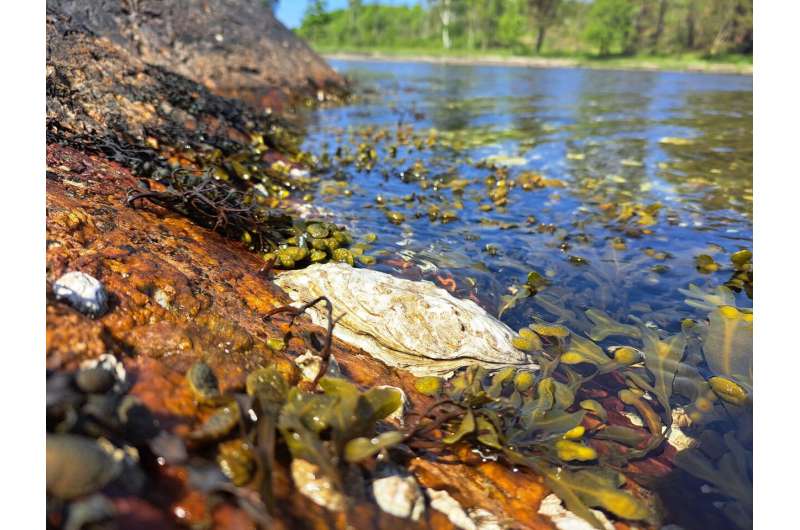This article has been reviewed according to Science X's editorial process and policies. Editors have highlighted the following attributes while ensuring the content's credibility:
fact-checked
peer-reviewed publication
trusted source
proofread
Pacific oysters are dominant on Sweden's west coast, shows study

The Pacific oyster has taken over in the Swedish west coast county of Bohuslän. Researchers at the University of Gothenburg have found that the invasive species accounts for two-thirds of the biomass of all mussel and oyster species. This is not necessarily a bad thing, except for beachgoers, who can cut themselves easily on the razor-sharp shells.
In the summer of 2007, a new species was observed in large numbers in shallow waters in Bohuslän. The new species was the invasive Pacific oyster (Magallana gigas), also known as the Japanese oyster. Researchers at the University of Gothenburg have now estimated the size of this Pacific oyster invasion for the first time.
In terms of biomass, the Pacific oyster is the most abundant bottom-dwelling species and accounts for about two-thirds of the total biomass, including blue mussels and European oysters.
"Although we conducted our survey in northern Bohuslän, it is likely that the situation is the same all the way down the Bohuslän coast," says Youk Greeve, Ph.D. student in marine biology at the University of Gothenburg.
May compete with blue mussels
As the European oyster usually lives at greater depths of between 1 and 30 meters, it is not certain that the Pacific oyster will outcompete its native relative. Wild-caught flat oysters from Grebbestad were recently granted protected designation of origin in the EU, placing them on a par with Swedish Kalixlöjrom vendace roe and French champagne.
Blue mussels, which also grow wild in shallow bays, may have a harder time of it.
"But we need more research to find out how the Pacific oyster is affecting blue mussel stocks," says Youk Greeve.
It is probable that the establishment of the oyster has had and will have far-reaching consequences for the ecology of Sweden's shallow coastal habitats. Pacific oysters grow on each other, creating reefs that provide new habitats in which other species live and thrive. They also filter large amounts of water, which affects plankton communities. The far-reaching impacts of the expanding oyster population remain to be studied.
The American razor clam buries itself in the seabed
This study, published in the scientific journal Frontiers in Marine Science, was conducted in 2021. Researchers surveyed the numbers of different mussel and oyster species on a number of nearshore seabeds in northern Bohuslän by collecting and analyzing all the mussels and oysters within designated squares laid out on the seabed. Results showed that two invasive species are now the most common species in Bohuslän. Besides the Pacific oyster, the American razor clam (Ensis leei), was the most common among sediment-dwelling species in terms of biomass.
"It's good at burrowing and does well even in areas where storms frequently blow the sand away," says Youk Greeve.
Humans are to blame for the spread of the Pacific oyster. When European oysters were wiped out by parasites in the 1960s, oyster farmers in Europe chose to bring in Pacific oysters that are more resistant to parasites. Evidence suggests that the first specimens of the invasive species blew across the Kattegat/Skagerak as larvae from Danish oyster farms in autumn 2006.
Oysters can only be picked by the landowner
In Swedish waters, the European oyster has survived parasitic diseases, with many people saying that the taste is different and that the European oyster tastes better.
"Of course we want to protect the native oyster on the west coast, but the Pacific oyster can't be eradicated. It's thriving and it's here to stay," says Youk Greeve.
This is where current legislation poses a problem. Today, only the landowner is allowed to pick oysters along Sweden's west coast. One suggestion is to allow the harvesting of Pacific oysters in bays for swimming and in other areas where there is a desire to protect native oysters from competition. In return, it would be permitted to grow Pacific oysters elsewhere, as there is a commercial interest in doing so.
"This would be a win-win solution for oyster farmers, local authorities and swimmers," says Youk Greeve.
More information: Youk Greeve et al, Estimating and scaling-up biomass and abundance of epi- and infaunal bivalves in a Swedish archipelago region: Implications for ecological functions and ecosystem services, Frontiers in Marine Science (2023). DOI: 10.3389/fmars.2023.1105999
Journal information: Frontiers in Marine Science
Provided by University of Gothenburg



















